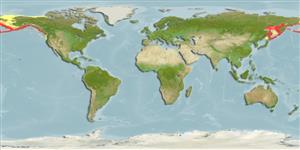>
Pleuronectiformes (Flatfishes) >
Pleuronectidae (Righteye flounders) > Hippoglossinae
Etymology: Hippoglossus: Greek, ippos = horse + Greek, glossa = tongue (Ref. 45335); stenolepis: From the Greek hippos (horse), glossa (tounge), steno (narrow), lepis, (scale). In 1904, a Russian scientist by the name of P.J. Schmidt first proposed the scientific name based on anatomical differences such as scale shape, pectoral fin length, and body shape which he thought distinguished it from the Atlantic halibut (Hippoglossus hippoglossus). (Ref. 94075).
Environment: milieu / climate zone / depth range / distribution range
Ecologia
marinhas demersal; oceanódromo (Ref. 51243); intervalo de profundidade 0 - 1200 m (Ref. 50550). Temperate; 73°N - 42°N, 138°E - 123°W (Ref. 54557)
North Pacific: Hokkaido, Japan and the Sea of Okhotsk to the southern Chukchi Sea and Point Camalu, Baja California, Mexico.
Comprimento de primeira maturação / Tamanho / Peso / Idade
Maturity: Lm ? range ? - ? cm
Max length : 258 cm TL macho/indeterminado; (Ref. 40637); 267.0 cm TL (female); peso máx. publicado: 363.0 kg (Ref. ); idade máx. registrada: 55 anos (Ref. 55701)
Espinhos dorsais (total): 0; Raios dorsais (total): 90-106; Espinhos anais 0; Raios anais : 69 - 80; Vértebras: 49 - 51. Dorsal origin above anterior part of pupil in upper eye, generally low, higher in middle. Caudal spread and slightly lunate. Pectorals small.
Found on various types of bottoms (Ref. 2850). Young are found near shore, moving out to deeper waters as they grow older (Ref. 6885). Older individuals typically move from deeper water along the edge of the continental shelf where they spend the winter, to shallow coastal water (27-274 m) for the summer (Ref. 28499). Feed on fishes, crabs, clams, squids, and other invertebrates (Ref. 6885). Utilized fresh, dried or salted, smoked and frozen; eaten steamed, fried, broiled, boiled, microwaved and baked (Ref. 9988).
Vinnikov, K.A., R.C. Thomson and T.A. Munroe, 2018. Revised classification of the righteye flounders (Teleostei: Pleuronectidae) based on multilocus phylogeny with complete taxon sampling. Molecular phylogenetics and evolution, 125:147-162. (Ref. 122998)
Status na Lista Vermelha da UICN (Ref. 130435)
Ameaça para os humanos
Harmless
Uso pelos humanos
Pescarias: altamente comercial; peixe esportivo: sim; Aquário: Aquários públicos
Mais informação
ReferênciasAquaculturaPerfil para aquaculturaEstirpesGenéticaElectrophoresesHereditariedadeDoençasProcessamentoNutrientsConversão de massa
Ferramentas
Relatórios especiais
Baixar XML
Fontes da internet
Estimates based on models
Preferred temperature (Ref.
123201): 0.3 - 5.7, mean 1.6 °C (based on 454 cells).
Índice de diversidade filogenética (Ref.
82804): PD
50 = 0.7500 [Uniqueness, from 0.5 = low to 2.0 = high].
Bayesian length-weight: a=0.00631 (0.00398 - 0.01000), b=3.14 (3.00 - 3.28), in cm total length, based on LWR estimates for this species & (Sub)family-body (Ref.
93245).
Nível Trófico (Ref.
69278): 4.1 ±0.2 se; based on diet studies.
Resiliência (Ref.
120179): Baixo, tempo mínimo de duplicação da população 4,5 - 14 anos (rm=0.2; K=0.05; tm=5-20; tmax=55).
Prior r = 0.11, 95% CL = 0.06 - 0.18, Based on 2 stock assessments.
Fishing Vulnerability (Ref.
59153): Very high vulnerability (86 of 100).
Climate Vulnerability (Ref.
125649): Moderate to high vulnerability (45 of 100).
Nutrients (Ref.
124155): Calcium = 8.89 [2.92, 21.69] mg/100g; Iron = 0.202 [0.078, 0.561] mg/100g; Protein = 18 [16, 20] %; Omega3 = 0.391 [0.169, 0.895] g/100g; Selenium = 42.3 [14.7, 110.0] μg/100g; VitaminA = 10.8 [2.5, 41.8] μg/100g; Zinc = 0.412 [0.179, 0.699] mg/100g (wet weight);
